Ball Cactus
- March 13, 2024
- 0 comment
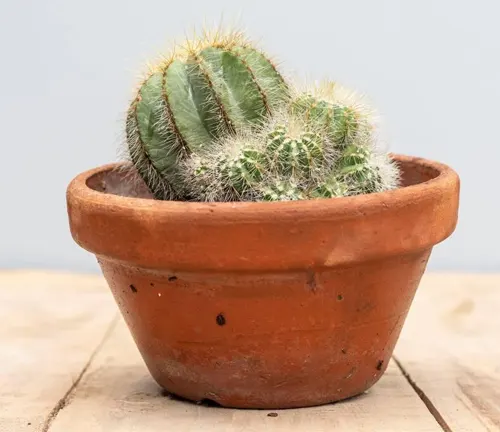
The Ball Cactus, also called Parodia magnifica, is a cool succulent plant that looks like a little green ball. It’s tough and can survive well indoors or outdoors with minimal care. People love it because it’s easy to take care of and looks really cool. This plant is great for beginners or anyone who wants a low-maintenance plant buddy. It doesn’t need a lot of water or attention, making it perfect for busy folks or those new to gardening.
Plus, its round shape and unique appearance make it a standout addition to any plant collection. Whether you place it on your desk, in your garden, or on a sunny windowsill, the Ball Cactus will bring a touch of charm and nature into your space. Its striking looks and easy care make it a popular choice for plant enthusiasts looking to add a special touch to their surroundings.
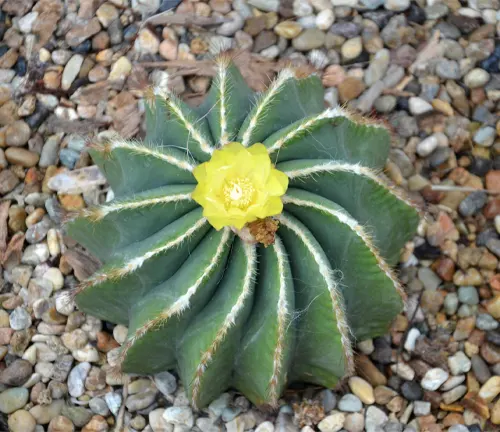
| Characteristics | Description |
| Scientific Name | Parodia magnifica |
| Common Names | Ball Cactus, Balloon Cactus, and Notocactus magnificus |
| Family | Cactaceae |
| Native Region | South America, particularly Brazil and Uruguay |
| Plant Type | Succulent/Cactus |
| Size | Generally grows to a diameter of 6-8 inches |
| Leaves | The Ball Cactus has small, spine-covered tubercles that give it a unique texture and appearance. |
| Flowers | It produces vibrant yellow flowers that bloom from the top of the plant in spring and summer. |
| Propagation | Propagation is typically achieved through seeds or, less commonly, by dividing offsets from the parent plant. |
| Drought Tolerance | Their adaptations make them exceptionally drought-tolerant, capable of surviving long periods without water. |
| Cultural Uses | Historically, indigenous peoples have utilized these plants for food, medicine, and ornamental purposes. |
| Ecological Role | They provide essential habitats and food sources for various desert wildlife, contributing significantly to their ecosystems. |
| Notable Species | Some notable species include Echinocactus grusonii (Golden Barrel Cactus) and Parodia leninghausii (Golden Ball Cactus). |
| Hardiness Zones | Most species thrive in USDA hardiness zones 9-11, requiring a warm, dry climate to prosper. |
| Growth Rate | They generally exhibit a slow growth rate, which contributes to their long lifespan. |
| Lifespan | With proper care, Ball Cacti can live for decades, with some species reaching over 100 years of age. |
Botanical Beauty of “Ball Cactus ”
The Ball Cactus, also known as Parodia magnifica, is a stunning plant that stands out with its round shape, prickly texture, and bright yellow flowers. These features make it a beautiful and eye-catching choice for gardens or succulent collections. Its unique appearance adds a touch of botanical beauty to any space, creating a visually appealing focal point that draws attention and admiration.
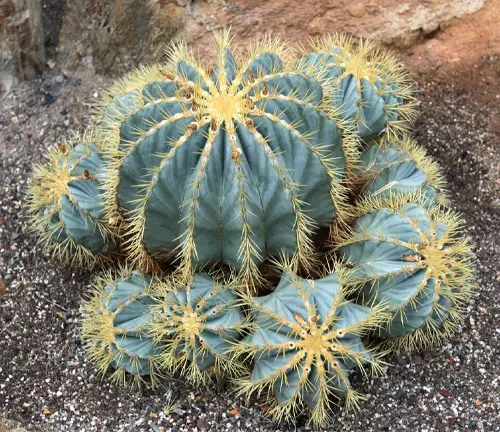
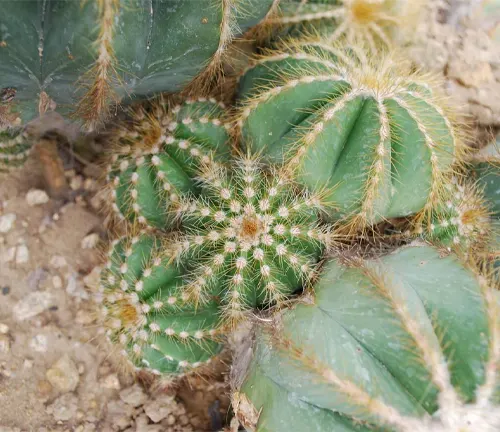
Woodland Elegance
In a garden designed with a xeriscape or desert theme, the Ball Cactus brings a sense of elegance and individuality. Its distinctive appearance sets it apart from other succulents and cacti, adding a special touch to the landscape. Placing the Ball Cactus in such a setting enhances the overall aesthetic appeal, creating a visually appealing contrast that highlights its beauty and charm.
Ecological Importance
In its natural home, the Ball Cactus plays a vital role in the ecosystem by offering food and shelter to wildlife in dry areas. Animals like birds and insects rely on the cactus for sustenance and protection, making it an essential part of the local environment. By supporting biodiversity and helping maintain the ecological balance, the Ball Cactus showcases its importance beyond its striking appearance.
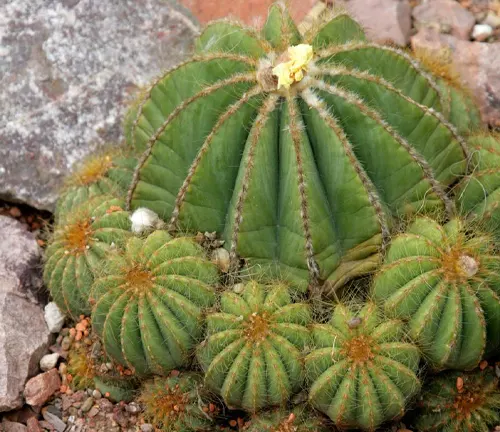
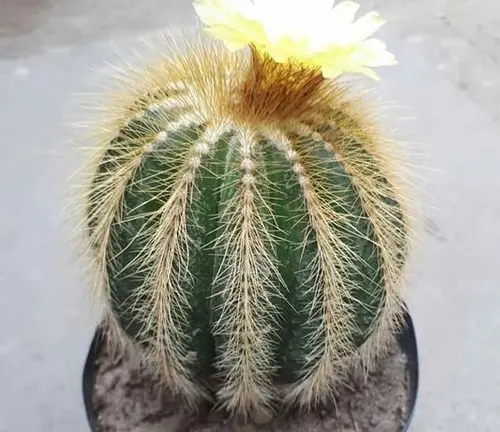
Cultivation and Conservation
Because the Ball Cactus is so well-liked for growing, people are working hard to protect it and grow more in a way that won’t harm the ones in the wild. This helps make sure we don’t take too many from their natural homes and keep them safe for the future. By conserving and responsibly growing more Ball Cactus plants, we can enjoy them without hurting the ones in their natural habitats. This way, we can appreciate their beauty while also helping to preserve them for generations to come.
Fragrance
The Ball Cactus may not have a noticeable fragrance, but its stunning looks more than compensate for this absence. Its unique spherical shape, spiny texture, and vibrant flowers create a visual feast for the eyes, making it a captivating addition to any space. While some plants entice with their scents, the Ball Cactus relies on its visual appeal to charm and impress admirers.
Despite not having a fragrance, the Ball Cactus’s beauty can enhance the ambiance of any room or garden. Its striking appearance can serve as a focal point or conversation starter, adding a touch of botanical elegance to its surroundings. Whether placed indoors or outdoors, the Ball Cactus’s lack of scent is overshadowed by its aesthetic allure, making it a popular choice for those who appreciate visually striking plants.
Soil Stabilization
The Ball Cactus, with its widespread root system, plays a crucial role in stabilizing the soil in its native environment. By spreading its roots deep and wide, this plant helps hold the soil together, preventing erosion in dry and arid regions. This soil stabilization is essential for maintaining the integrity of the land and preventing loss of valuable topsoil due to wind or water erosion.
In arid regions where water is scarce and soil erosion is a significant concern, the Ball Cactus’s ability to stabilize the soil is invaluable. By anchoring itself firmly in the ground and creating a network of roots, this plant helps keep the soil in place, reducing the risk of desertification and preserving the delicate balance of the ecosystem. The Ball Cactus’s contribution to soil stabilization highlights its importance beyond its aesthetic appeal, showcasing its role in maintaining the health of the environment it inhabits.
Common Uses
The Ball Cactus, besides being a pretty plant, has practical uses in landscaping. It’s commonly used in xeriscaping, which is a type of gardening that conserves water by using drought-tolerant plants like the Ball Cactus. This plant’s ability to thrive in dry conditions makes it a perfect choice for xeriscapes, where water conservation is key.
In rock gardens, the Ball Cactus adds texture and visual interest with its round shape and spiky appearance. Placing this cactus among rocks and gravel creates a striking contrast and enhances the overall aesthetic of the garden. Additionally, in container gardening, the Ball Cactus is a popular choice for adding a touch of greenery to small spaces like balconies or patios.
Its compact size and low maintenance requirements make it ideal for growing in pots or containers, bringing a unique charm to any outdoor setting.
Benefits
The Ball Cactus offers several benefits, making it a popular choice for gardeners and plant enthusiasts. One of its main advantages is its low water requirements, making it an eco-friendly choice for those who want to conserve water. By using this plant in their gardens, water-conscious individuals can enjoy a beautiful addition to their landscape without contributing to high water usage.
Furthermore, the Ball Cactus’s unique appearance adds visual interest to both landscapes and indoor spaces. Its spherical shape and spiny texture create a striking contrast, making it a standout addition to gardens or succulent collections. Indoors, the Ball Cactus can serve as a conversation starter or a focal point in a room, bringing a touch of nature and botanical beauty into the home.
In addition to its visual appeal, the Ball Cactus offers other benefits, such as soil stabilization and wildlife support in its native habitat. These factors contribute to its overall value and importance, making it a plant that not only looks great but also plays a vital role in its ecosystem.
Different Species
Echinocactus grusonii
Commonly known as the Golden Barrel Cactus, is one of the most iconic species, characterized by its spherical, ribbed body adorned with golden-yellow spines. This cactus blooms with yellow flowers at its crown and can grow up to 35 inches in diameter, making it a striking presence in any collection.
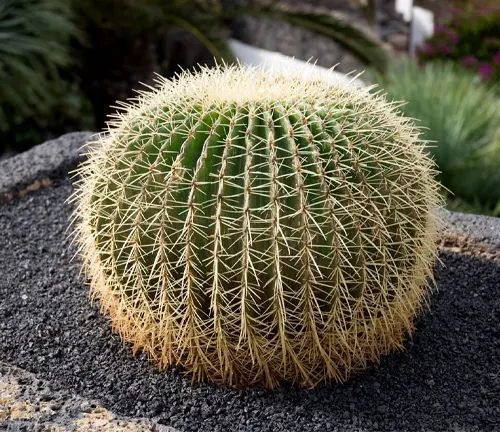
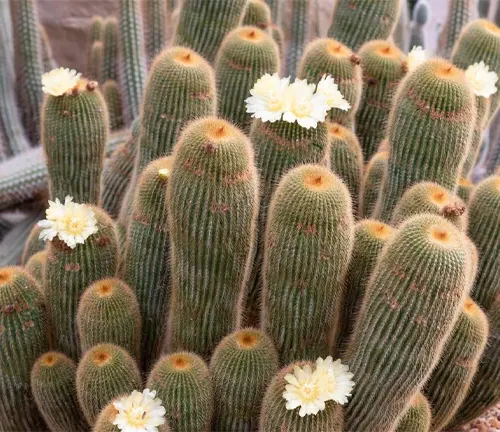
Parodia leninghausii
Or Golden Ball Cactus, which boasts an elongated, ball-like shape covered in dense, soft, golden spines. It produces bright yellow flowers that encircle the top of the stem and typically reach about 4-6 inches in diameter.
Notocactus magnificus
also known as the Balloon Cactus, features a green body with a spherical to slightly elongated shape. Its body is ribbed, with closely spaced areoles and yellow spines, and it blooms with bright yellow flowers. This species usually grows up to 8 inches in diameter.
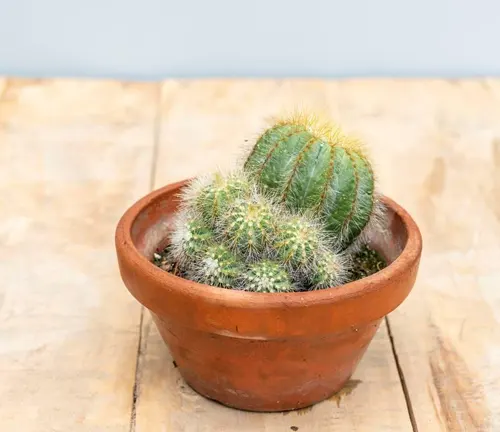

Gymnocalycium mihanovichii
commonly referred to as the Chin Cactus, is distinguished by its small, spherical shape and a lack of significant spines. It varies in color from green to purple and blooms with white or pink flowers, remaining relatively small at about 2-3 inches in diameter.
Mammillaria bombycina
or Silken Pincushion Cactus, has a spherical shape with dense white spines and hooked central spines, giving it a fluffy appearance. It produces small, pink flowers that form a crown around the top of the plant and typically grows to about 5 inches in diameter.
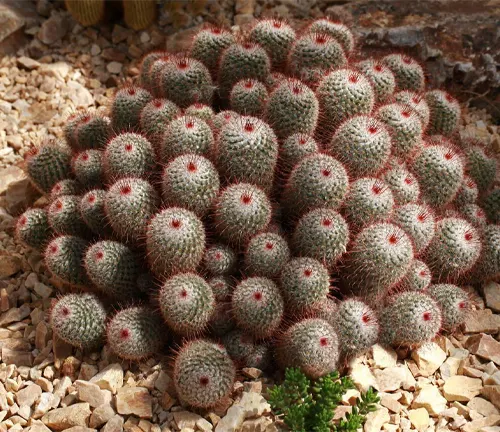
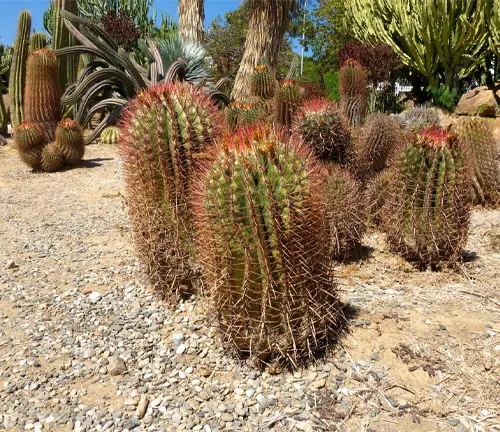
Ferocactus pilosus
known as the Mexican Fire Barrel Cactus, has a cylindrical shape that becomes more spherical with age and features striking red spines. It blooms with red or yellow flowers and can reach up to 24 inches in diameter.
Astrophytum asterias
or Star Cactus, has a small, spineless, round, flat body that resembles a sand dollar, marked with white dots. It blooms with large, yellow flowers and is usually between 2-6 inches in diameter.

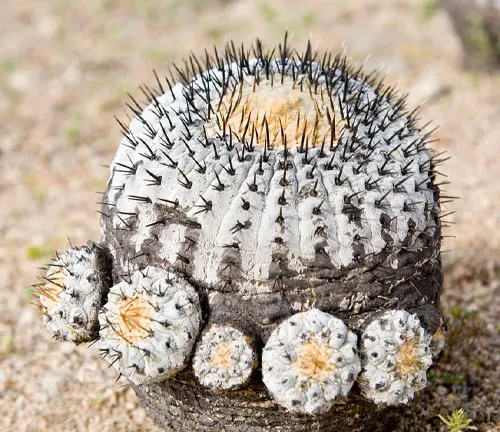
Copiapoa cinerea
or Silver Ball Cactus, is known for its spherical, blue-gray body covered with a dense layer of white down and black spines. It produces small, yellow flowers and can grow up to 4 inches in diameter.
Frequently Asked Questions (FAQs)
1. What is a Ball Cactus?
The Ball Cactus, or Parodia magnifica, is a type of succulent plant known for its distinctive spherical shape and ease of care. It is native to South America and prized for its unique appearance and minimal care requirements.
2. How often should I water my Ball Cactus?
Ball Cacti are drought-tolerant and require minimal watering. During the growing season (spring and summer), water when the soil completely dries out. In winter, reduce watering to once a month or less, depending on your indoor conditions.
3. Does the Ball Cactus produce flowers?
Yes, the Ball Cactus produces vibrant yellow flowers that bloom from the top of the plant, typically in spring and summer. The flowering adds a beautiful contrast to its green spherical body.
4. Can the Ball Cactus be grown indoors?
Absolutely! The Ball Cactus is well-suited for indoor growth, requiring a sunny spot like a south-facing window. Its compact size and low maintenance make it a perfect indoor plant.
5. What are the main benefits of having a Ball Cactus?
The Ball Cactus offers several benefits, including low water requirements, making it eco-friendly and easy to care for. Its spherical shape and bright flowers can add aesthetic appeal to any space, indoors or out.
6. Is the Ball Cactus suitable for beginners?
Yes, its resilience and minimal care requirements make the Ball Cactus ideal for beginners or those new to gardening. It’s a forgiving plant that can thrive with minimal attention.
7. How can I propagate my Ball Cactus?
Propagation is typically done through seeds or by dividing offsets from the parent plant. It’s a simple process that can help you expand your collection or share with friends.
8. What are the ecological roles of the Ball Cactus?
In its native habitat, the Ball Cactus provides essential habitats and food sources for various desert wildlife, contributing significantly to its ecosystems and supporting biodiversity.
9. Can the Ball Cactus help with soil stabilization?
Yes, with its widespread root system, the Ball Cactus helps stabilize the soil in dry and arid regions, preventing erosion and maintaining the ecological balance.
10. Are there different species of Ball Cactus?
Indeed, there are several species considered “Ball Cacti,” including the Echinocactus grusonii (Golden Barrel Cactus) and the Parodia leninghausii (Golden Ball Cactus), each with unique characteristics and appearances.


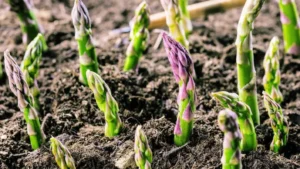

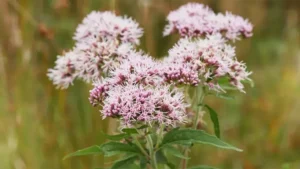
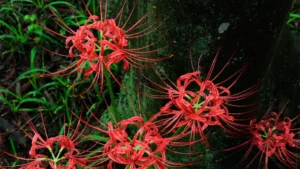
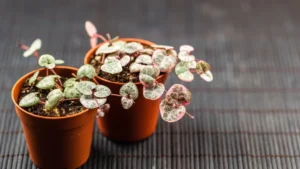



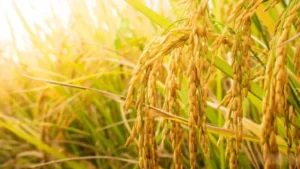
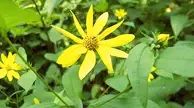
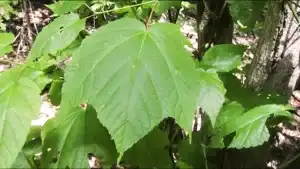
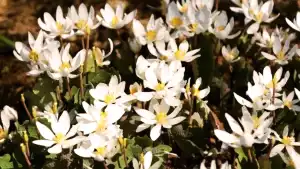
Leave your comment